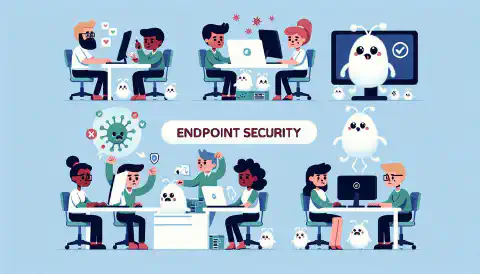Top 5 Linux Security and Hardening Techniques: Boost System Defense Today!

Table of Contents
The Top 5 Linux Hardening Techniques to Improve System Security
Linux system security is a crucial aspect of maintaining the overall integrity and safety of your computer network. Without proper security measures in place, your systems are vulnerable to various threats such as unauthorized access, data breaches, and malware attacks. This article aims to provide an in-depth understanding of Linux system security and presents the top 5 Linux hardening techniques to significantly improve your system’s security posture.
Understanding Linux System Security
The Importance of System Security
In today’s digital age, where cyber threats continue to evolve and increase in sophistication, system security has never been more critical. A compromised system can lead to severe consequences, including financial loss, damage to reputation, and privacy breaches. It is essential for organizations and individuals alike to prioritize system security to safeguard their sensitive information and maintain the integrity of their operations.
When it comes to system security, Linux stands out as a robust and secure operating system. Its open-source nature allows for continuous improvement and scrutiny by a vast community of developers and security experts. This collaborative approach ensures that vulnerabilities are quickly identified and patched, making Linux a reliable choice for those seeking a secure computing environment.
Basic Concepts of Linux Security
In Linux, security is not an afterthought but a fundamental design principle. Key concepts such as process isolation, file permissions, and user management form the foundation of Linux security. Understanding these concepts is vital for implementing effective security measures and hardening your Linux systems.
Process isolation is a key feature of Linux security. Each process runs in its own isolated environment, preventing unauthorized access to system resources. This isolation ensures that if one process is compromised, it cannot affect the rest of the system. Linux achieves this through the use of process control mechanisms, such as the fork and exec system calls, which create and manage processes securely.
File permissions play a crucial role in Linux security. Each file and directory in the system has specific permissions assigned to it, determining who can read, write, or execute it. By carefully managing these permissions, system administrators can restrict access to sensitive files, preventing unauthorized modifications or data breaches.
User management is another essential aspect of Linux security. Linux allows for the creation of multiple user accounts, each with its own set of permissions and privileges. By assigning the appropriate privileges to each user, system administrators can ensure that only authorized individuals have access to critical system resources. Additionally, Linux provides tools for enforcing strong password policies and implementing multi-factor authentication, further enhancing system security.
Furthermore, Linux offers a wide range of security features and tools that can be leveraged to enhance system security. These include firewall management tools, intrusion detection systems, and encryption mechanisms. By utilizing these features effectively, system administrators can create layered defenses that protect against a variety of threats.
Overall, understanding the basic concepts of Linux security is crucial for anyone responsible for maintaining and securing Linux systems. By implementing robust security measures and staying informed about the latest security best practices, organizations and individuals can mitigate the risks posed by cyber threats and ensure the safety of their valuable data and operations.
An Overview of Linux Hardening
What is Linux Hardening?
Linux hardening refers to the process of securing a Linux system by implementing various security measures and best practices. These measures aim to reduce the system’s attack surface, minimize vulnerabilities, and enhance its resistance against unauthorized access and malicious activities.
When it comes to Linux hardening, there are several key areas that are typically addressed. One of the first steps is to ensure that the system is running the latest version of the Linux kernel. This is important because new releases often include security patches and bug fixes that address known vulnerabilities. Additionally, Linux hardening involves configuring the system’s firewall to restrict incoming and outgoing network traffic, as well as implementing access controls to limit user privileges.
Another crucial aspect of Linux hardening is securing the system’s authentication mechanisms. This includes enforcing strong password policies, implementing two-factor authentication, and disabling unused accounts. By implementing these measures, the risk of unauthorized access to the system is significantly reduced.
Furthermore, Linux hardening also involves regular monitoring and auditing of the system’s logs. This allows administrators to detect and respond to any suspicious activities or potential security breaches promptly. Additionally, system hardening may include installing and configuring intrusion detection and prevention systems, which can help identify and block malicious activities in real-time.
Why is Linux Hardening Essential?
Linux, being an open-source operating system, is widely used across a diverse range of devices and environments. Its popularity makes it an attractive target for attackers. By hardening your Linux systems, you mitigate the risk of security breaches and fortify your defenses against potential threats.
Without proper hardening, Linux systems can be vulnerable to various attacks, such as unauthorized access, malware infections, and data breaches. Attackers can exploit vulnerabilities in the system to gain unauthorized access, compromise sensitive information, or disrupt critical services. By implementing security measures and best practices, Linux hardening helps protect the system’s integrity, confidentiality, and availability.
Linux hardening is especially crucial in environments where sensitive data is stored or transmitted. This includes organizations that handle financial information, personal data, or intellectual property. By hardening Linux systems, these organizations can meet regulatory compliance requirements and ensure that their data is adequately protected.
Moreover, Linux hardening is an ongoing process. As new threats and vulnerabilities emerge, it is essential to stay up-to-date with the latest security practices and regularly review and update the hardening measures in place. By continuously improving the security posture of Linux systems, organizations can stay one step ahead of potential attackers and minimize the risk of security incidents.
Top 5 Linux Hardening Techniques
Linux is a highly secure operating system, but implementing additional hardening techniques can further enhance the security of your systems. In this article, we will explore the top 5 Linux hardening techniques that you should consider implementing to protect your systems from potential threats.
1. Regular System Updates and Patch Management
One of the most critical aspects of Linux hardening is keeping your systems up to date with the latest security patches and updates. Regularly applying patches addresses known vulnerabilities and ensures that your system is fortified against known attack vectors.
However, it is not just enough to install updates. You should also have a well-defined patch management process in place. This includes testing patches in a controlled environment before deploying them to production systems. By doing so, you can ensure that the updates do not introduce any compatibility issues or conflicts with existing software.
2. User Account Management and Privilege Control
Implementing robust user account management practices is essential for maintaining system security. This includes creating strong passwords , enforcing password policies, and limiting user privileges to only what is necessary to perform their duties.
Additionally, you should regularly review user accounts and remove any unnecessary or unused accounts. This reduces the attack surface by minimizing the number of potential entry points for attackers. It is also recommended to implement multi-factor authentication (MFA) for privileged accounts to add an extra layer of security.
3. Firewall Configuration and Management
Configuring and managing firewalls is crucial for protecting your Linux systems from unwanted network traffic and unauthorized access attempts. By properly configuring firewall rules and monitoring incoming and outgoing network connections, you can effectively control the flow of data to and from your systems.
When configuring your firewall, it is important to follow the principle of least privilege. Only allow network traffic that is necessary for your systems to function properly. Regularly review and update firewall rules to ensure that they align with your organization’s security policies.
4. System Monitoring and Intrusion Detection
Implementing system monitoring tools and intrusion detection systems (IDS) enables you to identify and respond to potential security incidents promptly. These tools provide real-time monitoring of system logs, network traffic, and system activities, allowing you to detect and mitigate security breaches.
Monitoring tools can help you identify any unusual or suspicious activities on your systems. By setting up alerts and notifications, you can be immediately notified when a potential security incident occurs. This allows you to take immediate action to investigate and mitigate the threat.
5. File System Security and Encryption
Safeguarding your Linux system’s file system is crucial for protecting sensitive data. By implementing file system encryption and access controls, you ensure that even if an attacker gains unauthorized access to your system, they will have limited visibility into your data.
File system encryption ensures that data is encrypted at rest, providing an additional layer of protection. Access controls, on the other hand, allow you to define who can access specific files or directories. By implementing granular access controls, you can ensure that only authorized users have access to sensitive data.
By implementing these top 5 Linux hardening techniques, you can significantly enhance the security of your systems. However, it is important to note that security is an ongoing process. Regularly reviewing and updating your security measures is essential to stay ahead of emerging threats and protect your systems effectively.
Implementing Linux Hardening Techniques
Step-by-step Guide to Apply Hardening Techniques
Implementing Linux hardening techniques requires a systematic approach to ensure comprehensive coverage and minimize the risk of overlooking critical security measures. Here is a step-by-step guide to help you implement Linux hardening techniques effectively:
1. Assess System Vulnerabilities: Conduct a thorough vulnerability assessment to identify potential security gaps in your Linux systems.
During the vulnerability assessment, it is important to consider both external and internal threats. External threats can come from malicious actors trying to gain unauthorized access to your systems, while internal threats can arise from disgruntled employees or accidental misconfigurations. By conducting a comprehensive assessment, you can gain a clear understanding of the vulnerabilities present in your Linux systems.
Some common vulnerabilities to look out for include outdated software versions, unpatched security vulnerabilities, weak user passwords, and misconfigured firewall rules. By identifying these vulnerabilities, you can prioritize your hardening efforts and address the most critical issues first.
2. Apply Patches and Updates: Regularly update your Linux systems with the latest patches and updates to address known vulnerabilities.
Software vendors regularly release patches and updates to fix security vulnerabilities and improve system performance. It is crucial to stay up-to-date with these patches and updates to ensure that your Linux systems are protected against the latest threats.
Implementing a patch management process can help streamline the update process and ensure that critical security patches are applied in a timely manner. This process can involve testing patches in a controlled environment before deploying them to production systems to minimize the risk of compatibility issues or system downtime.
3. Implement User Access Controls: Enforce strong password policies, implement multi-factor authentication, and limit user privileges based on the principle of least privilege.
User access controls are essential for maintaining the security of your Linux systems. By enforcing strong password policies, such as requiring a combination of uppercase and lowercase letters, numbers, and special characters, you can reduce the risk of password-based attacks.
Implementing multi-factor authentication adds an extra layer of security by requiring users to provide additional verification, such as a fingerprint or a one-time passcode, in addition to their password. This can significantly reduce the risk of unauthorized access even if a user’s password is compromised.
Limiting user privileges based on the principle of least privilege ensures that users only have access to the resources and commands necessary for their job roles. By restricting unnecessary privileges, you can minimize the potential damage that can be caused by a compromised user account.
4. Configure Firewalls: Set up firewalls to control inbound and outbound network traffic, ensuring that only authorized connections are allowed.
Firewalls act as a barrier between your Linux systems and the outside world, monitoring and controlling network traffic based on predefined rules. By configuring firewalls to allow only authorized connections, you can protect your systems from unauthorized access and potential attacks.
When configuring firewalls, it is important to consider both inbound and outbound traffic. Inbound traffic refers to connections initiated from external sources, while outbound traffic refers to connections initiated from your Linux systems. By carefully defining firewall rules, you can ensure that only necessary network traffic is allowed, reducing the attack surface and improving overall system security.
5. Enable System Monitoring: Deploy system monitoring and intrusion detection tools to monitor system activities, network traffic, and log files for any signs of compromise.
System monitoring is crucial for detecting and responding to security incidents in a timely manner. By deploying monitoring tools, you can gain insights into system activities, network traffic patterns, and log files, allowing you to identify any abnormal behaviors or signs of compromise.
Monitoring tools can provide real-time alerts for suspicious activities, such as unauthorized access attempts or unusual network traffic. By promptly investigating and responding to these alerts, you can mitigate potential security breaches and minimize the impact on your Linux systems.
6. Encrypt Sensitive Data: Implement file system encryption to protect sensitive data, ensuring that unauthorized access to your systems does not lead to compromise of valuable information.
Data encryption is a crucial component of overall system security. By encrypting sensitive data, you can ensure that even if an attacker gains unauthorized access to your Linux systems, they will not be able to read or use the encrypted data without the encryption key.
There are various encryption techniques available for Linux systems, such as full disk encryption, file-level encryption, and database encryption. Depending on the nature of your sensitive data and the level of protection required, you can choose the appropriate encryption method to safeguard your information.
Common Challenges and Solutions
While implementing Linux hardening techniques, certain challenges may arise. Here are some common challenges and their solutions:
- Complexity: Linux hardening can be complex, especially for organizations with diverse and distributed systems. Leveraging automation tools and frameworks can help streamline the implementation process.
Automation tools and frameworks can simplify the process of implementing Linux hardening techniques by providing predefined configurations and scripts that can be applied across multiple systems. These tools can automate tasks such as patch management, user access control configuration, and firewall rule deployment, reducing the manual effort required and ensuring consistency across your Linux infrastructure.
- Compatibility: Some security measures may conflict with existing applications or configurations. Conduct thorough testing and ensure compatibility before implementing changes.
Before implementing any security measures, it is important to thoroughly test them in a controlled environment to ensure compatibility with your existing applications and configurations. This can help identify any potential conflicts or issues that may arise during the implementation process.
By conducting compatibility testing, you can mitigate the risk of system disruptions and ensure that the security measures you implement do not negatively impact the functionality or performance of your Linux systems.
- User Awareness: Users play a critical role in system security. Educate and train them on best practices, such as password hygiene and safe browsing habits.
While implementing Linux hardening techniques is important, it is equally important to educate and train your users on best practices for system security. Users should be aware of the importance of strong passwords , the risks associated with phishing attacks, and the need to follow safe browsing habits.
Regular security awareness training sessions can help reinforce these best practices and ensure that users understand their role in maintaining the security of your Linux systems. By fostering a culture of security awareness, you can significantly reduce the risk of human error leading to security incidents.
- Ongoing Maintenance: System security is an ongoing process. Regularly review and update security measures to adapt to evolving threats and vulnerabilities.
Implementing Linux hardening techniques is not a one-time activity. It is important to regularly review and update your security measures to adapt to evolving threats and vulnerabilities.
Stay informed about the latest security trends and vulnerabilities affecting Linux systems. Subscribe to security mailing lists, follow security blogs, and participate in relevant forums to stay updated. By staying proactive and continuously improving your security measures, you can effectively protect your Linux systems against emerging threats.
Conclusion
Linux system security is paramount in today’s digital landscape, where cyber threats are ever-present. By implementing the top 5 Linux hardening techniques discussed in this article, you can significantly enhance the security of your Linux systems and reduce the risk of security breaches. Regular system updates, robust user account management, firewall configuration, system monitoring, and file system security contribute to a multi-layered defense strategy that bolsters your system’s resilience against threats.






